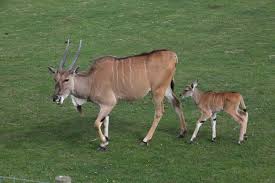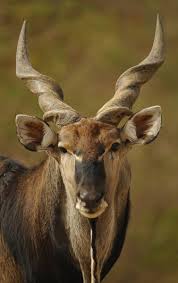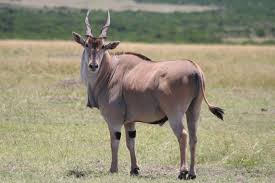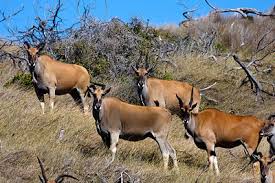The common eland, also known as the southern eland or eland antelope, is a savannah and plains antelope found
in East and Southern Africa. It is a species of the family Bovidae and genus Taurotragus. It was first
described by Peter Simon Pallas in 1766. An adult male is around 1.6 metres (5') tall at the shoulder
(females are 20 centimetres (8") shorter) and can weigh up to 942 kg (2077 lbs) with an average of 500-600
kilograms (1,100-1,300 lb, 340-445 kilograms (750-980 lb) for females). It is the second largest antelope
in the world, being slightly smaller on average than the giant eland.
Mainly a herbivore, its diet is primarily grasses and leaves. Common elands form herds of up to 500 animals,
but are not territorial. The common eland prefers habitats with a wide variety of flowering plants such as
savannah, woodlands, and open and montane grasslands; it avoids dense forests. It uses loud barks, visual
and postural movements and the flehmen response to communicate and warn others of danger. The common eland
is used by humans for leather, meat, and rich, nutritious milk, and has been domesticated in many areas.
It is native to Botswana, Burundi, the Democratic Republic of the Congo, Ethiopia, Kenya, Lesotho, Malawi,
Mozambique, Namibia, Rwanda, South Africa, South Sudan, Swaziland, Tanzania, Uganda, Zambia and Zimbabwe but
is no longer present in Burundi and Angola. While the common eland's population is decreasing, it is
classified as "Least Concern" by the International Union for Conservation of Nature (IUCN).
Description
Common elands are spiral-horned antelopes. They are sexually dimorphic, with females being smaller than the
males. Females weigh 300-600 kg (660-1,320 lb), measure 200-280 cm (79-110 in) from the snout to the base of
the tail and stand 125-153 cm (49-60 in) at the shoulder. Bulls weigh 400-942 kg (882-2,077 lb), are 240-345
cm (94-136 in) from the snout to the base of the tail and stand 150-183 cm (59-72 in) at the shoulder. The
tail is 50-90 cm (20-35 in) long. Male elands can weigh up to 1,000 kg (2,200 lb).
Their coat differs geographically, with elands in north Africa having distinctive markings (torso stripes,
markings on legs, dark garters and a spinal crest) that are absent in the south. Apart from a rough mane,
the coat is smooth. Females have a tan coat, while the coats of males are darker, with a bluish-grey tinge.
Bulls may also have a series of vertical white stripes on their sides (mainly in parts of the Karoo in
South Africa). As males age, their coat becomes more grey. Males also have dense fur on their foreheads and
a large dewlap on their throats.
Both sexes have horns with a steady spiral ridge (resembling that of the bushbuck). The horns are visible
as small buds in newborns and grow rapidly during the first seven months. The horns of males are thicker
and shorter than those of females (males' horns are 43-66 centimetres (17-26 in) long and females' are 51-69
centimetres (20-27 in) long), and have a tighter spiral. Males use their horns during rutting season to
wrestle and butt heads with rivals, while females use their horns to protect their young from predators.
The common eland is the slowest antelope, with a peak speed of 40 kilometres (25 mi) per hour that tires
them quickly. However, they can maintain a 22 kilometres (14 mi) per hour trot indefinitely. Elands are
capable of jumping up to 2.5 metres (8 ft 2 in) from a standing start when startled (up to 3 metres (9.8 ft)
for young elands). The common eland's life expectancy is generally between 15 and 20 years; in captivity
some live up to 25 years.
Eland herds are accompanied by a loud clicking sound that has been subject to considerable speculation. It
is believed that the weight of the animal causes the two halves of its hooves to splay apart, and the
clicking is the result of the hoof snapping together when the animal raises its leg. The sound carries some
distance from a herd, and may be a form of communication.
Habitat and distribution
Common elands live on the open plains of southern Africa and along the foothills of the great southern
African plateau. The species extends north into Ethiopia and most arid zones of South Sudan, east into
western Angola and Namibia, and south to South Africa. However, there is a low density of elands in Africa
due to poaching and human settlement.
Elands prefer to live in semi-arid areas that contain many shrub-like bushes, and often inhabit grasslands,
woodlands, sub-desert, bush, and mountaintops with altitudes of about 15,000 ft (4600 m). Elands do,
however, avoid forests, swamps and deserts. The places inhabited by elands generally contain Acacia,
Combretum, Commiphora, Diospyros, Grewia, Rhus and Ziziphus trees and shrubs; some of these also serve as
their food.
Eland can be found in many National Parks and reserves today, including Nairobi and Tsavo East National
Park, Tsavo West National Park, Masai Mara NR, Kenya; Serengeti, Ruaha and Tarangire National Park,
Ngorongoro Crater, Tanzania; Kagera National Park, Rwanda; Nyika National Park, Malawi; Luangwa Valley and
Kafue National Park, Zambia; Hwange National Park, Matobo National Park, Tuli Safari Area and Chimanimani
Eland Sanctuary, Zimbabwe; Kruger National Park, Kgalagadi Transfrontier Park, Giant's Castle and
Suikerbosrand NR, South Africa.
They live on home ranges that can be 200-400 km2 for females and juveniles and 50 km2 for males.
Diet
Common elands are herbivores that browse during drier winter months but have also adapted to grazing during
the rainy season when grasses are more common. They require a high-protein diet of succulent leaves from
flowering plants but will consume lower quality plant material if available including forbs, trees, shrubs,
grasses, seeds and tubers. The eland can conserve water by increasing its body temperature. Grasses the eland
eats include Setaria and Themeda and fruits from Securinega and Strychnos. Large antelope can survive on
lower quality food in times of little rain. Elands feed during the night in hot weather and sleep for long
periods during the day.
Most of their water is obtained from their food, though they will drink water when available. As they
quickly adjust to the surroundings due to seasonal changes and other causes, they also change their feeding
habits. They also use their horns to break off branches that are hard to reach.
Behavior
Common elands are nomadic and crepuscular. They eat in the morning and evening, rest in shade when hot and
remain in sunlight when cold. They are commonly found in herds of up to 500, with individual members
remaining in the herd anywhere from several hours to several months. Juveniles and mothers tend to form
larger herds, while males may separate into smaller groups or wander individually. During estrus, mainly in
the rainy season, groups tend to form more regularly. In southern Africa common elands will often associate
with herds of zebras, roan antelopes and oryxes.
Common elands communicate via gestures, vocalizations, scent cues and display behaviors. The flehmen
response also occurs, primarily in males in response to contact with female urine or genitals. Females will
urinate to indicate fertility during the appropriate phase of their estrous cycle, as well as to indicate
their lack of fertility when harassed by males. If eland bulls find any of their predators nearby, they will
bark and attempt to attract the attention of others by trotting back and forth until the entire herd is
conscious of the danger. Some of their main predators include lions, African wild dogs, cheetahs and spotted
hyenas. Juvenile elands are more vulnerable than adults to their predators.
Reproduction

Females are sexually mature at 15-36 months and males at 4-5 years. Mating may occur anytime after reaching
sexual maturity, but is mostly seen in the rainy season. In Zambia, young are born in July and August, while
elsewhere it is the mating season. Mating begins when elands gather to feed on lush green plains with
plentiful grass, and some males and females start mating with each other in separate pairs. Males chase the
females to find out if they are in estrus. They also test the female's urine. Usually, a female chooses the
most dominant and fit male to mate with. Sometimes she runs away from males trying to mate, causing more
attraction. This results in fights between males, in which their hard horns are used. It is 2-4 hours before
a female allows a male to mount. Males usually keep close contact with females in the mating period. The
dominant male can mate with more than one female. Females have a gestation period of 9 months, and give
birth to only one calf each time.
Males, females and juveniles each form separate social groups. The male groups are the smallest; the members
stay together and search for food or water sources. The female group is much larger and covers greater
areas. They travel the grassy plains in wet periods and prefer bushy areas in dry periods. Females have a
complex linear hierarchy. The nursery and juvenile group is naturally formed when females give birth to
calves. After about 24 hours of the delivery, the mother and calf join this group. The calves start
befriending each other and stay back in the nursery group while the mother returns to the female group.
The calves leave the nursery group when they are at least two years old and join a male or female group.
Conservation
Currently, common elands are not endangered. They are conserved by the United States Endangered Species Act,
and regulated in international trade by the Convention on International Trade in Endangered Species. Using
ground counts and aerial surveys, the International Union for Conservation of Nature (IUCN) calculates the
population density of the common eland to be between 0.05 and 1 per square kilometre with a total population
estimate of 136,000. Populations are considered stable or increasing in the countries of Namibia, Botswana,
Zimbabwe, South Africa, Malawi and possibly Tanzania.
The population is, however, gradually decreasing due to habitat loss, caused by expanding human settlements
and poaching for its superior meat. As they are docile and inactive most of the time, they can easily be
killed. The species became extinct in Swaziland and Zimbabwe, but has been reintroduced.
The IUCN states that about half of the estimated total population lives in protected areas and 30% on private
land. Protected areas that support major populations include Omo (Ethiopia), Serengeti, Katavi, Ruaha and
Selous-Kilombero (Tanzania), Kafue and North Luangwa (Zambia), Nyika (Malawi), Etosha (Namibia), Kgalagadi
Transfrontier Park (Botswana/South Africa) and Ukhahlamba Drakensberg Park (South Africa). Most of these
populations appear to be stable. Relatively large numbers of common eland now live on private land,
particularly in Namibia, Zimbabwe and South Africa, reflecting its value as a trophy animal. Common elands
have also been widely domesticated in Zimbabwe, South Africa and Kenya, as well as in Russia, Ukraine and
England.









